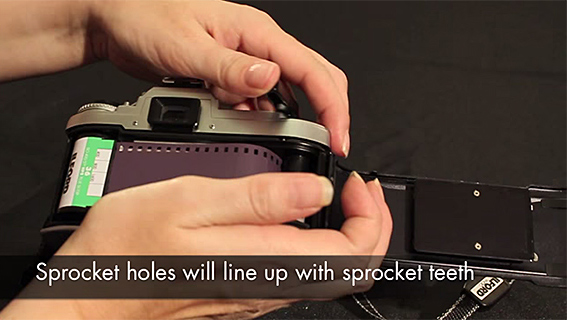If you’re a young, new photographer, you probably aren’t too familiar with shooting film. Mind you, analogue is making a comeback, but digital is definitely the norm these days. Digital photography is just easier—less time and less money spent on materials. But, there is magic in film. If you’re getting (back) into film photography, you’ll want to make as few mistakes as possible so you don’t mess up or lose images. The best place to start is with proper loading and unloading of the film:
When you first open your new film, you’ll notice there’s a piece of it sticking out, this is the film leader. Don’t worry, it’s supposed to be there.
Opening the Back of the Camera
For many manual cameras, like the Zenit 412LS, the back opens when you pull up on the rewind knob. (Important: Never force the back of the camera open as you can damage it.) If the back doesn’t pop open, check the bottom of the camera for a lock, like on the Nikon F2.
Loading the Cassette
Manual Film Loading Cameras (example: Nikon FG)
- Place the cassette in the film chamber on the left-hand side.
- Push the rewind knob back down to secure the film.
- Pull the film leader across the film guide and feed it into the take up spool.
- Advance the film using the film advance lever (on top right of camera) until the sprocket teeth catch the sprocket holes.
- Close the back of the camera.
Tensioning the Film
The film is loaded, but it’s really loose in there. You want to tighten it so it winds properly and captures perfect images. Fold out the rewind crank on the knob and turn in the direction of the arrow until you feel slight resistance.
The first few frames of the film are pretty much useless now, as they were exposed to light during the loading. This is normal and expected. Just skip past these frames by pressing the shutter release button and advancing the film until the counter shows the number 1.
Make sure the rewind knob is rotating as you advance the film. If not, you need to reload.
On some cameras, you’ll need to set the film speed; do so according to the film you are using.
Automatic Film Loading Cameras (example: Canon EOS-1)
This is much easier than manual loading. First of all, there are metal pins in the film chamber that read the DX code on the cassette and set the film speed automatically.
As long as the film leader is lined up correctly along the film guide to the take up spool, you don’t have to do anything else. Just close the back of the camera and it will automatically wind and tension the film.
Unloading the Cassette
An automatic camera will rewind itself when the film is used up.
Manual Unloading
You’ll know when you’ve taken your last shot because the film advance lever won’t move anymore. You’ll need to rewind manually:
- Find the film release button if there is one (check user guide if you can’t find it) and hold it down while you turn the rewind crank.
- Rewind until you feel the tension give; that’s the take up spool releasing the film. Keep rewinding a bit more to make sure the film goes all the way back inside the cassette.
- Open the back of the camera.
- Lift up the rewind knob to release the cassette.
Now you can take your film cassette into a developer—if you’re lucky enough to have one in the area. If not, there are plenty of online process and print services where you can send it.
Like This Article?
Don't Miss The Next One!
Join over 100,000 photographers of all experience levels who receive our free photography tips and articles to stay current:









So great to see tutorials out there for this getting started in film. I remember back in art school our professor had us practice doing this blindfolded. That way you could load your camera in a dark closet or bathroom and would be able to squeeze 4-5 extra shots out of the portion of the film that is normally exposed when your load it in the light. I still load my film that way. You always want to get as many shots as you can out of a roll of film, especially now that their prices are on the incline :)